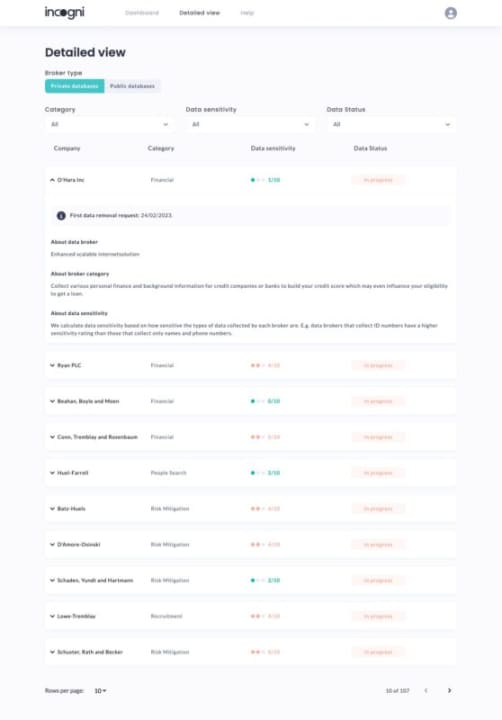We picked up the phone and on the other end of the line, someone offered us a new insurance for the car we just bought. How can they know that? Did that company see us entering the dealership? To answer this question, we must first understand what happens with our personal information when we move through the web.
Data drives the web’s business, and it does so without us noticing
Personal data has become of immense value in the era of constant intercommunication. Knowing who we are, where we are, our age or gender, and whether we just bought a vehicle is essential to make that call and offer that insurance. And there’s a whole industry working under the “Accept” buttons in cookie dialogs to collect this data. The collection of personal data goes unnoticed by many but not by all.

Over time and with the use of services on the web, various data brokers buy, sell, extract, share, and analyze loads of data about our interests, personal information, place of residence, job, and much more. Is it possible to remedy this? It’s hard, but possible. We can contact the company responsible for a certain website to delete our data. Have they already shared it with their “business partners”? Then we’ll have to contact them too. And, before we even start, we’re likely to give up.
This is where services like Incogni, an initiative by Surfshark, come in, promising an effective solution for those of us wanting to protect our online (and offline) privacy.
A service that takes care of the hardest part of our privacy
The mere prospect of having to personally remove our data from the web is a Herculean task. Incogni is presented as a solution to what requires halting this invasion of privacy. Offered by Surfshark, already recognized for its security tools like Surfshark VPN, Incogni is an automated personal data removal service. It works by deleting personal information from the databases of hundreds of data brokers. It leverages data protection laws like the CCPA, UK-GDPR, GDPR, and PIPEDA to offer services in the United States, United Kingdom, European Union, Switzerland, and Canada.

For us, the process is really simple. We just need to create an account, provide Incogni with the authorization to act on our behalf, and wait while they manage the deletion of our data. Incogni handles all the communication with data brokers, including objections to deletion and tracking of denied requests, saving us the time it would take to perform these complex processes ourselves.
More importantly, once the information is removed, what prevents it from being collected again? Incogni guarantees a constant scanning of data brokers to detect both new information and the reappearance of previously deleted data. This service is based on how often different brokers update information and on the use of exclusion lists that some of them offer.
Should I really subscribe to Incogni?
“Should I really subscribe to Incogni?” is a valid question many ask when considering the protection of their online privacy. The answer starts with understanding how and why our personal data are available to be collected, sold, and used, most of the time without our consent.
A simple way to realize the extent of the problem is to search for ourselves on the internet. The results can be surprisingly detailed, and we shouldn’t stop at whether our name appears in the search results. Some sites reveal information ranging from past and present physical addresses to possible public records and more. When assessing the severity of the situation, consider that many of these services require payment to access the information.
The second way to evaluate the convenience of cleaning up our personal information on the web is through the phone calls and various promotions we may receive. A very clear indicator that our data are circulating in unwanted places. Not all robocalls or spam calls we receive are the same, as it’s different to be offered a magazine subscription on a topic of interest to us than to know which electricity company we use and propose improving the offer we have, even providing details about what we are currently paying.

Something similar happens with junk mail. We all receive it, but not all messages are equal. If they address us by name, try to impersonate recognized entities, even providing certain identifying data, or seem to have too detailed knowledge of some aspect of what they propose, all alarms should go off.
The same applies, finally, to advertising. It’s true that ads seem to follow us everywhere, but there’s a limit. Evaluating whether the degree of tracking seems normal is also a factor in determining if we need a personal data removal service.
The list could go on. Health insurance companies can raise rates based on a person’s online activity, collecting data through data brokers. The same applies to selling services like travel, airplane tickets, hotel bookings, etc.
So, should I subscribe to Incogni? If we are concerned about the privacy of our data, want to reduce the number of robocalls and, above all, if any of the situations described clearly reflect our day-to-day experience, it’s probably a good idea. With a price of $6.49 per month, the investment is really interesting, and we can quickly see the results.
Not all data removal services are the same
Even though laws and regulations on data privacy offer us theoretical protection, effectively removing personal information from data brokers’ databases can be an extremely long and tedious process, exceeding 300 hours for a single cleanup. And this is not the worst part, as mentioned earlier, this effort may be insufficient since data brokers often collect personal information again after some time, turning data removal into a task that requires continuous attention.

In this context, the fact that Incogni is a subscription service, not a one-time payment, addresses this problem by performing repeated and ongoing deletions, ensuring that our personal data stay off the market.
Since the law has positioned itself against the indiscriminate collection of data in various parts of the world and has given us options and tools to curb the proliferation of our personal information on the web, several services of this kind have emerged. Not all are equal. Incogni stands out for its broad coverage, for example, because unlike other services that focus primarily on the U.S., Incogni offers services in the U.S., UK, EU, Switzerland, and Canada.
It’s also worth noting that while most services are limited to people search sites, though these are important, Incogni addresses a broader range of data broker types. Necessary to counteract the varied adverse effects of too much exposure of our data.
Moreover, the fact that Incogni comes from the professionals at Surfshark, means the service benefits from substantial experience in developing online security tools. Finally, it’s important to highlight that Incogni covers the entire data removal process for us. We won’t receive follow-up from data brokers that we might have to deal with; the service does not leave the removal part in our hands like others, it takes care of the process in a constant and complete manner.
We know that privacy is a fundamental right, but the reality of the personal data market often puts that right at risk. Incogni offers us a robust and practical solution for those of us looking to protect our information from data brokers. An additional layer of protection that will bring an end to the days of sharing our data without our knowledge or consent.



